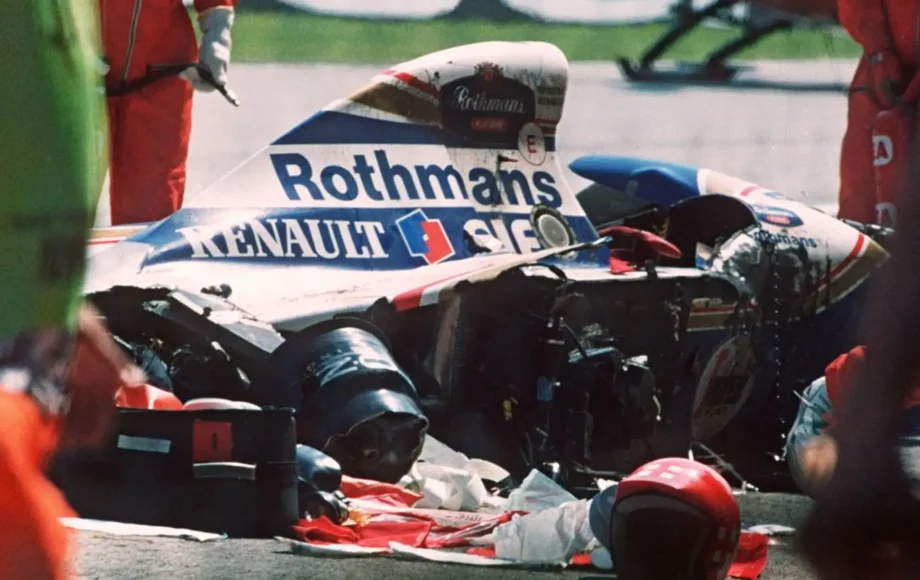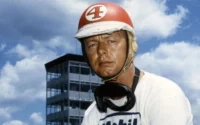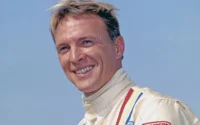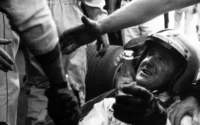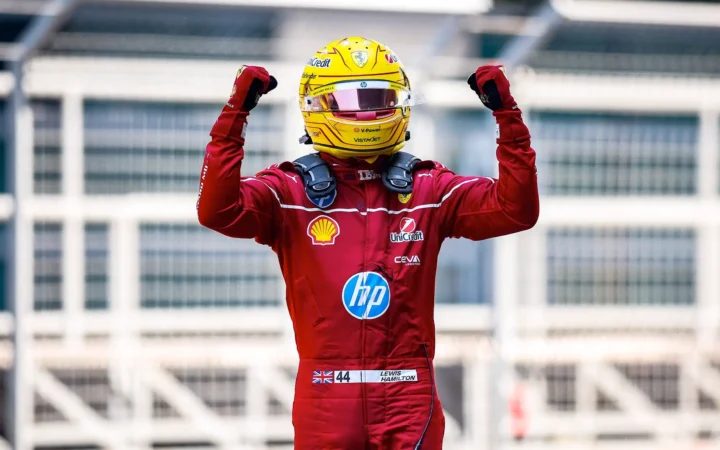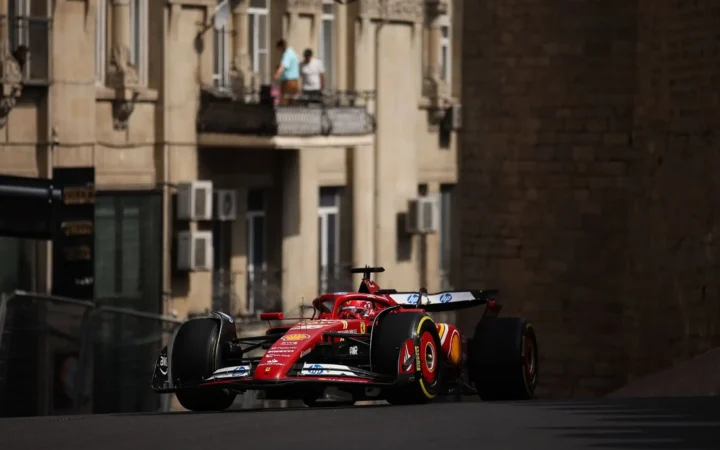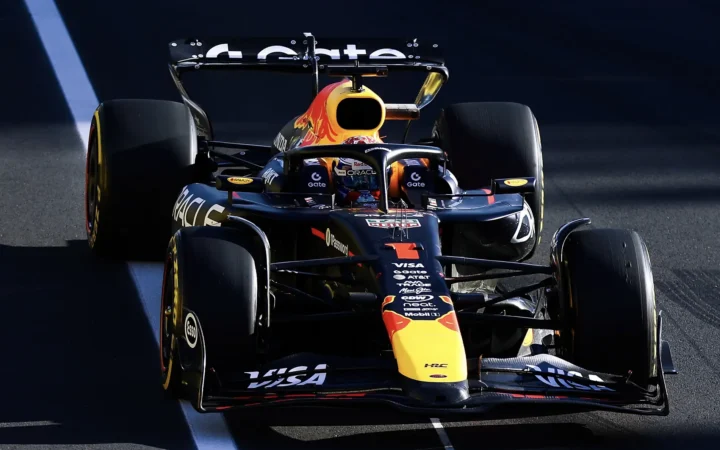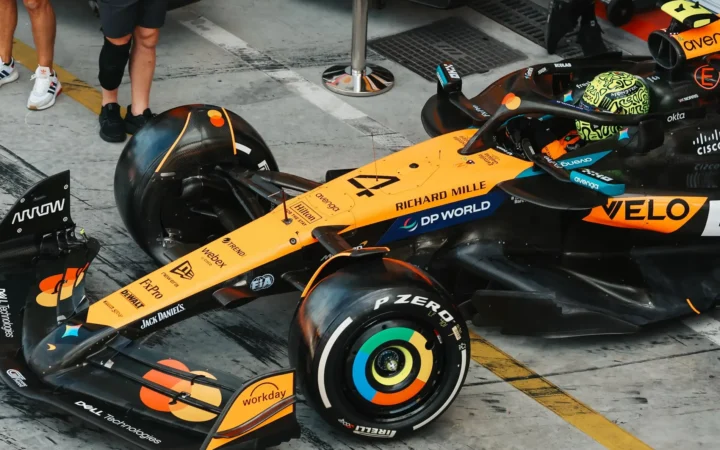What happened on this day, May 1 in Formula 1 history? Find out interesting facts and stories about Formula 1 on this day.
1898
On May 1, 1898, Renaud de Montaignac de Chauvance, the Marquis de Montaignac was involved in motor racing’s first fatal accident when he lost control and inadvertently caused a crash that killed his mechanic. After swerving and forcing another car off the road, he then lost control of his own car, which rolled, leading to his mechanic’s instant death and his own several hours later. De Chauvance accepted full responsibility for the tragedy before his death.
1928
Desmond Titterington was born in Belfast on May 1, 1928. He began his racing career in Ulster before advancing to European circuits and joining Ecurie Ecosse. His success in a Jaguar led to a Formula One race for the Connaught team at the British Grand Prix on 14 July 1956, he scored no championship points. He also competed in several non-Championship Grand Prix eventually retiring from racing to focus on his business, relocating to Scotland amid increasing local tensions in Ireland. He died in Dundee, Scotland, aged 73 on 13 April 2002.
1951
Geoff Lees was born on May 1, 1951. A Warwickshire, England native, he struggled with un-competitive Formula One cars despite self-financing his way into the sport. He competed in 12 Formula One World Championship Grands Prix, debuting on July 16, 1978. He did not earn any championship points. During his F1 career, Lees found himself in less competitive cars, and after limited success, he relocated to Japan in the early 1980s. There, he had a fruitful career in the Japanese Formula Two series, clinching the 1983 championship and achieving eight wins. He also competed for various Japanese teams in sports car racing championships, securing three titles in the Fuji Grand Champion Series in 1986, 1988, and 1989, and winning the C-class title in the All Japan Sports Prototype Championship in 1992. Lees earned great respect in the Japanese racing community. He also raced multiple times at Le Mans, with his highest finish being sixth place in 1990.
1955
On May 1, 1955, F1 driver Mike Nazaruk, who raced exclusively in the Indianapolis 500, which was a part of the F1 calendar in the earlier seasons, died in a Sprint Car race accident at the Langhorne Speedway after his car crashed through a fence and rolled multiple times. Advised against racing due to illness, Nazaruk insisted on competing for financial reasons. His daughter poignantly reflected on the perils of racing, recalling her grandfather’s similar fate.
1972
Emerson Fittipaldi clinched the 1972 Spanish Grand Prix win in a Lotus, propelling him to the top of the 1972 drivers’ championship alongside Denny Hulme, who retired during the race due to gearbox issues. Jacky Ickx finished second for the Ferrari team and his teammate Clay Regazzoni came in third.
1972 Spanish Grand Prix Race Results
| Pos | No | Driver | Car | Laps | Time/retired | Pts |
|---|---|---|---|---|---|---|
| 1 | 5 | Emerson Fittipaldi | Lotus Ford | 90 | 2:03:41.230 | 9 |
| 2 | 4 | Jacky Ickx | Ferrari | 90 | +18.920s | 6 |
| 3 | 6 | Clay Regazzoni | Ferrari | 89 | +1 lap | 4 |
| 4 | 26 | Andrea de Adamich | Surtees Ford | 89 | +1 lap | 3 |
| 5 | 20 | Peter Revson | McLaren Ford | 89 | +1 lap | 2 |
| 6 | 29 | Carlos Pace | March Ford | 89 | +1 lap | 1 |
| 7 | 22 | Wilson Fittipaldi | Brabham Ford | 88 | +2 laps | 0 |
| 8 | 12 | Tim Schenken | Surtees Ford | 88 | +2 laps | 0 |
| 9 | 21 | Dave Walker | Lotus Ford | 87 | DNF | 0 |
| 10 | 18 | Graham Hill | Brabham Ford | 86 | +4 laps | 0 |
| 11 | 14 | Henri Pescarolo | March Ford | 86 | +4 laps | 0 |
| NC | 1 | Jackie Stewart | Tyrrell Ford | 69 | DNF | 0 |
| NC | 9 | Chris Amon | Matra | 66 | DNF | 0 |
| NC | 3 | Francois Cevert | Tyrrell Ford | 65 | DNF | 0 |
| NC | 8 | Peter Gethin | BRM | 65 | DNF | 0 |
| NC | 11 | Denny Hulme | McLaren Ford | 48 | DNF | 0 |
| NC | 25 | Howden Ganley | BRM | 38 | DNF | 0 |
| NC | 10 | Reine Wisell | BRM | 24 | DNF | 0 |
| NC | 7 | Mario Andretti | Ferrari | 23 | DNF | 0 |
| NC | 15 | Mike Hailwood | Surtees Ford | 20 | DNF | 0 |
| NC | 2 | Ronnie Peterson | March Ford | 16 | DNF | 0 |
| NC | 16 | Rolf Stommelen | Eifelland Ford | 15 | DNF | 0 |
| NC | 19 | Jean-Pierre Beltoise | BRM | 9 | DNF | 0 |
| NC | 24 | Niki Lauda | March Ford | 7 | DNF | 0 |
| NC | 28 | Alex Soler-Roig | BRM | 6 | DNF | 0 |
1983
The 1983 San Marino Grand Prix on May 1 saw challenging conditions with over half of the starting grid unable to finish due to a deteriorating track. Patrick Tambay emerged victorious for Ferrari amid frequent pit stops and a faltering field. Riccardo Patrese lost an early advantage by missing his pit stop but managed to challenge Tambay until a critical spin-off. Alain Prost came home in second for Renault, followed by Rene Arnoux in the sister Ferrari in third.
1983 San Marino Grand Prix Race Results
| Pos | No | Driver | Car | Laps | Time/retired | Pts |
|---|---|---|---|---|---|---|
| 1 | 27 | Patrick Tambay | Ferrari | 60 | 1:37:52.460 | 9 |
| 2 | 15 | Alain Prost | Renault | 60 | +48.781s | 6 |
| 3 | 28 | Rene Arnoux | Ferrari | 59 | +1 lap | 4 |
| 4 | 1 | Keke Rosberg | Williams Ford | 59 | +1 lap | 3 |
| 5 | 7 | John Watson | McLaren Ford | 59 | +1 lap | 2 |
| 6 | 29 | Marc Surer | Arrows Ford | 59 | +1 lap | 1 |
| 7 | 2 | Jacques Laffite | Williams Ford | 59 | +1 lap | 0 |
| 8 | 30 | Chico Serra | Arrows Ford | 58 | +2 laps | 0 |
| 9 | 26 | Raul Boesel | Ligier Ford | 58 | +2 laps | 0 |
| 10 | 23 | Mauro Baldi | Alfa Romeo | 57 | DNF | 0 |
| 11 | 9 | Manfred Winkelhock | ATS BMW | 57 | +3 laps | 0 |
| 12 | 12 | Nigel Mansell | Lotus Ford | 56 | DNF | 0 |
| NC | 6 | Riccardo Patrese | Brabham BMW | 54 | DNF | 0 |
| NC | 22 | Andrea de Cesaris | Alfa Romeo | 45 | DNF | 0 |
| NC | 11 | Elio de Angelis | Lotus Renault | 43 | DNF | 0 |
| NC | 5 | Nelson Piquet | Brabham BMW | 41 | DNF | 0 |
| NC | 25 | Jean-Pierre Jarier | Ligier Ford | 39 | DNF | 0 |
| NC | 4 | Danny Sullivan | Tyrrell Ford | 37 | DNF | 0 |
| NC | 35 | Derek Warwick | Toleman Hart | 27 | DNF | 0 |
| NC | 31 | Corrado Fabi | Osella Ford | 20 | DNF | 0 |
| NC | 36 | Bruno Giacomelli | Toleman Hart | 20 | DNF | 0 |
| NC | 8 | Niki Lauda | McLaren Ford | 11 | DNF | 0 |
| NC | 34 | Johnny Cecotto | Theodore Ford | 11 | DNF | 0 |
| NC | 3 | Michele Alboreto | Tyrrell Ford | 10 | DNF | 0 |
| NC | 33 | Roberto Guerrero | Theodore Ford | 3 | DNF | 0 |
| NC | 16 | Eddie Cheever | Renault | 1 | DNF | 0 |
1988
Six years prior to his untimely death, Ayrton Senna clinched a dominant win on May 1 at the 1988 San Marino Grand Prix, leading from start to finish. Despite starting issues, his teammate Alain Prost secured second place, with both McLarens outpacing the field. Senna managed a brake issue that caused smoke to enter his cockpit. Nelson Piquet, who finished third, remarked on the unlikelihood of challenging the McLarens, referencing a Brazilian saying about enduring hope: “We have a saying in Brazil,” he shrugged. “Hope is the last thing that dies.”
1988 San Marino Grand Prix Race Results
| Pos | No | Driver | Car | Laps | Time/retired | Pts |
|---|---|---|---|---|---|---|
| 1 | 12 | Ayrton Senna | McLaren Honda | 60 | 1:32:41.264 | 9 |
| 2 | 11 | Alain Prost | McLaren Honda | 60 | +2.334s | 6 |
| 3 | 1 | Nelson Piquet | Lotus Honda | 59 | +1 lap | 4 |
| 4 | 20 | Thierry Boutsen | Benetton Ford | 59 | +1 lap | 3 |
| 5 | 28 | Gerhard Berger | Ferrari | 59 | +1 lap | 2 |
| 6 | 19 | Alessandro Nannini | Benetton Ford | 59 | +1 lap | 1 |
| 7 | 18 | Eddie Cheever | Arrows Megatron | 59 | +1 lap | 0 |
| 8 | 2 | Satoru Nakajima | Lotus Honda | 59 | +1 lap | 0 |
| 9 | 17 | Derek Warwick | Arrows Megatron | 58 | +2 laps | 0 |
| 10 | 14 | Philippe Streiff | AGS Ford | 58 | +2 laps | 0 |
| 11 | 24 | Luis Perez-Sala | Minardi Ford | 58 | +2 laps | 0 |
| 12 | 29 | Yannick Dalmas | Lola Ford | 58 | +2 laps | 0 |
| 13 | 6 | Riccardo Patrese | Williams Judd | 58 | +2 laps | 0 |
| 14 | 3 | Jonathan Palmer | Tyrrell Ford | 58 | +2 laps | 0 |
| 15 | 15 | Mauricio Gugelmin | March Judd | 58 | +2 laps | 0 |
| 16 | 23 | Adrian Campos | Minardi Ford | 57 | +3 laps | 0 |
| 17 | 30 | Philippe Alliot | Lola Ford | 57 | +3 laps | 0 |
| 18 | 27 | Michele Alboreto | Ferrari | 54 | DNF | 0 |
| NC | 33 | Stefano Modena | Euro Brun Ford | 52 | +8 laps | 0 |
| NC | 4 | Julian Bailey | Tyrrell Ford | 48 | DNF | 0 |
| NC | 5 | Nigel Mansell | Williams Judd | 42 | DNF | 0 |
| NC | 31 | Gabriele Tarquini | Coloni Ford | 40 | DNF | 0 |
| NC | 36 | Alex Caffi | Dallara Ford | 18 | DNF | 0 |
| NC | 9 | Piercarlo Ghinzani | Zakspeed | 16 | DNF | 0 |
| NC | 16 | Ivan Capelli | March Judd | 2 | DNF | 0 |
1994
The darkest weekend in F1 history culminated in the death of Ayrton Senna on May 1 at the 1994 Imola Grand Prix. A weekend that would profoundly impact Formula 1, sparking significant safety reforms. On the morning of his final race, Senna convened a meeting with fellow drivers to push for enhanced track safety, following the fatal crash of Roland Ratzenberger the previous day. Senna, who had earlier predicted a dangerous season under the new regulations, was deeply shaken by Ratzenberger’s death. Despite advice from Professor Sid Watkins to withdraw, Senna felt compelled to race, stating, “Sid, there are certain things over which we have no control. I cannot quit; I have to go on.” They were the last words Senna spoke to Watkins. Tragically, on the seventh lap, he collided with the concrete wall at the flat-out left-hander Tamburello corner at over 160 mph and died instantly.
Michael Schumacher won the race in a Benetton Ford. In the press conference after the race, Schumacher said that he “couldn’t feel satisfied, couldn’t feel happy” with his win following the events that had happened during the race weekend. Nicola Larini scored the first points of his career when he finished in second position for Ferrari. Mika Hakkinen finished third for McLaren.
1994 Imola Grand Prix Race Results
| Pos | No | Driver | Car | Laps | Time/retired | Pts |
|---|---|---|---|---|---|---|
| 1 | 5 | Michael Schumacher | Benetton Ford | 58 | 1:28:28.642 | 10 |
| 2 | 27 | Nicola Larini | Ferrari | 58 | +54.942s | 6 |
| 3 | 7 | Mika Hakkinen | McLaren Peugeot | 58 | +70.679s | 4 |
| 4 | 29 | Karl Wendlinger | Sauber Mercedes | 58 | +73.658s | 3 |
| 5 | 3 | Ukyo Katayama | Tyrrell Yamaha | 57 | +1 lap | 2 |
| 6 | 0 | Damon Hill | Williams Renault | 57 | +1 lap | 1 |
| 7 | 30 | Heinz-Harald Frentzen | Sauber Mercedes | 57 | +1 lap | 0 |
| 8 | 8 | Martin Brundle | McLaren Peugeot | 57 | +1 lap | 0 |
| 9 | 4 | Mark Blundell | Tyrrell Yamaha | 56 | +2 laps | 0 |
| 10 | 12 | Johnny Herbert | Lotus Mugen Honda | 56 | +2 laps | 0 |
| 11 | 26 | Olivier Panis | Ligier Renault | 56 | +2 laps | 0 |
| 12 | 25 | Eric Bernard | Ligier Renault | 55 | +3 laps | 0 |
| 13 | 9 | Christian Fittipaldi | Footwork Ford | 54 | DNF | 0 |
| NC | 15 | Andrea de Cesaris | Jordan Hart | 49 | DNF | 0 |
| NC | 24 | Michele Alboreto | Minardi Ford | 44 | DNF | 0 |
| NC | 10 | Gianni Morbidelli | Footwork Ford | 40 | DNF | 0 |
| NC | 23 | Pierluigi Martini | Minardi Ford | 37 | DNF | 0 |
| NC | 31 | David Brabham | Simtek Ford | 27 | DNF | 0 |
| NC | 34 | Bertrand Gachot | Pacific Ilmor | 23 | DNF | 0 |
| NC | 19 | Olivier Beretta | Larrousse Ford | 17 | DNF | 0 |
| NC | 28 | Gerhard Berger | Ferrari | 16 | DNF | 0 |
| NC | 2 | Ayrton Senna | Williams Renault | 5 | DNF | 0 |
| NC | 20 | Erik Comas | Larrousse Ford | 5 | DNF | 0 |
2016
Nico Rosberg dominated the 2016 Russian Grand Prix, converting pole position into victory ahead of Mercedes teammate Lewis Hamilton, with Kimi Raikkonen securing third for Ferrari.
Rosberg’s win extended his streak to seven consecutive Grand Prix victories, while his title rival, Sebastian Vettel, saw his race end on the first lap after being hit by Daniil Kvyat. With a perfect 100 points from the season’s first four races, Rosberg left Russia with a commanding 43-point lead over Hamilton in the championship standings.
2016 Russian Grand Prix Race Results
| Pos | No | Driver | Car | Laps | Time/retired | Pts |
|---|---|---|---|---|---|---|
| 1 | 6 | Nico Rosberg | Mercedes | 53 | 1:32:41.997 | 25 |
| 2 | 44 | Lewis Hamilton | Mercedes | 53 | +25.022s | 18 |
| 3 | 7 | Kimi Räikkönen | Ferrari | 53 | +31.998s | 15 |
| 4 | 77 | Valtteri Bottas | Williams Mercedes | 53 | +50.217s | 12 |
| 5 | 19 | Felipe Massa | Williams Mercedes | 53 | +74.427s | 10 |
| 6 | 14 | Fernando Alonso | McLaren Honda | 52 | +1 lap | 8 |
| 7 | 20 | Kevin Magnussen | Renault | 52 | +1 lap | 6 |
| 8 | 8 | Romain Grosjean | Haas Ferrari | 52 | +1 lap | 4 |
| 9 | 11 | Sergio Perez | Force India Mercedes | 52 | +1 lap | 2 |
| 10 | 22 | Jenson Button | McLaren Honda | 52 | +1 lap | 1 |
| 11 | 3 | Daniel Ricciardo | Red Bull Racing TAG Heuer | 52 | +1 lap | 0 |
| 12 | 55 | Carlos Sainz | Toro Rosso Ferrari | 52 | +1 lap | 0 |
| 13 | 30 | Jolyon Palmer | Renault | 52 | +1 lap | 0 |
| 14 | 9 | Marcus Ericsson | Sauber Ferrari | 52 | +1 lap | 0 |
| 15 | 26 | Daniil Kvyat | Red Bull Racing TAG Heuer | 52 | +1 lap | 0 |
| 16 | 12 | Felipe Nasr | Sauber Ferrari | 52 | +1 lap | 0 |
| 17 | 21 | Esteban Gutierrez | Haas Ferrari | 52 | +1 lap | 0 |
| 18 | 94 | Pascal Wehrlein | MRT Mercedes | 51 | +2 laps | 0 |
| NC | 33 | Max Verstappen | Toro Rosso Ferrari | 33 | DNF | 0 |
| NC | 5 | Sebastian Vettel | Ferrari | 0 | DNF | 0 |
| NC | 27 | Nico Hulkenberg | Force India Mercedes | 0 | DNF | 0 |
| NC | 88 | Rio Haryanto | MRT Mercedes | 0 | DNF | 0 |
| Note – Sainz received a 10-second time penalty for forcing another driver off the track. Nasr received a 5-second time penalty for not respecting the race director’s instructions. | ||||||
F1 Driver Birthdays 1 May
| Birthday | F1 Driver |
|---|---|
| 1 May 1928 | Desmond Titterington (d. 2002) |
| 1 May 1951 | Geoff Lees |
F1 Driver Deaths 1 May
| Death | F1 Driver |
|---|---|
| 1 May 1955 | Mike Nazaruk (b. 1921) |
| 1 May 1994 | Ayrton Senna (b. 1960) |
| 1 May 1999 | Brian Shawe-Taylor (b. 1915) |
| 1 May 2015 | Geoff Duke (b. 1923) |
| 1 May 2023 | Giancarlo Gagliardi (b. 1943) |
Seen in:

